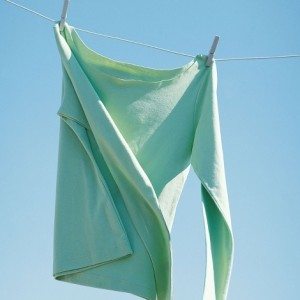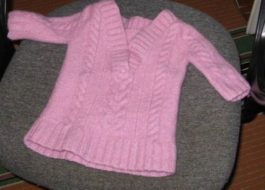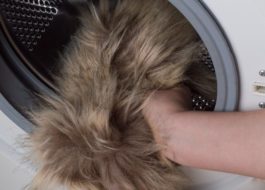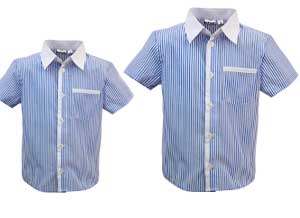How to wash viscose correctly so that the item does not shrink?
 Popular and capricious viscose. We wash it correctly! Viscose has been known for its advantages since the century before last. The durable, flowing fabric has the most “natural” base compared to other artificial products: wood pulp and pressed plants. By changing the thickness or nature of the fibers, man learned to make fabrics similar to linen, cotton, and wool from “artificial silk.”
Popular and capricious viscose. We wash it correctly! Viscose has been known for its advantages since the century before last. The durable, flowing fabric has the most “natural” base compared to other artificial products: wood pulp and pressed plants. By changing the thickness or nature of the fibers, man learned to make fabrics similar to linen, cotton, and wool from “artificial silk.”
If the composition contains a high percentage of viscose, then this is an excellent purchase with the following advantages:
- Strong, durable fabric, pleasant to the touch and intense in color;
- Excellent moisture absorption and air permeability;
- It has good resistance to sweat and does not become electrified.
Due to the smoothness of the fabric, viscose does not become dirty for quite a long time. This product is easy to wash without losing its shape or color. But if you do not take into account the peculiarities of caring for viscose, new bright clothes will turn into unnecessary shapeless rags after the first wash.
Does a viscose item shrink after washing?
Viscose is an extremely whimsical lady and requires very careful treatment. She will not tolerate negligence and inattention. First of all, you need to study the composition of the fabric on the label, and only after that decide how to wash viscose.
When wet, the fiber loses half its strength and becomes vulnerable.
Possible consequences of unsuccessful washing
- If the fabric contains cotton or acrylic, if the product is of low quality, the product may shrink. When using hot water, deformation cannot be avoided.If wool is added to the main composition, with a sharp temperature change, the clothing can shrink significantly. A mother’s “washed” sweater can be safely given to her daughter, while children’s clothes will look like a doll’s outfit.
- If you steam the product during ironing, use a centrifuge to spin it, or organize drying incorrectly, the fabric will stretch. Often this process is irreversible.
- If there is a high percentage of polyester, pilling may form after several washes.
- If the product contains 100% viscose, such clothes are least susceptible to deformation both during washing and during wear. It’s not for nothing that manufacturers add viscose to the fabric for additional strength and shine.
Let's move on to the recommendations!
How to wash viscose? Step-by-step recommendations for hand and machine washing
- Carefully study the product care instructions on the clothing label. They are the most reliable advisers. Perhaps only dry cleaning is suitable for you and you shouldn’t risk it at home?
- Be sure to separate light-colored fabrics from colored ones. Ideally, viscose does not fade, but when washing it is better to use special detergents for bright or white items separately.
- The most reliable type of cleaning is dry. Before washing, thoroughly wipe the product with a dry soft brush, removing dust and possible dirt.
- The best option is hand washing. Powder for delicate or thin fabrics is added to lukewarm water. Half an hour of soaking - and you can start washing. Viscose will not tolerate rough handling. It cannot be twisted, crushed or rubbed intensively. You need to wash with light massaging movements and remove moisture by shaking.When choosing detergents, it is worth studying their composition. If it contains a concentrated alkali solution, such washing is destructive to viscose.
- You should pay attention to the washing conditions for white viscose. This fabric is notable for the fact that it does not fade, which means it does not require bleaching. But exposure to bright sunlight can cause spots to appear. In this case, it is necessary to use bleach with sodium hypochloride. However, hydrogen peroxide will also work.
- When machine washing, it is best to use a laundry bag. The modes used are “delicate” or “for silk” without a spin function. It is best to wash with similar fabrics; rough items may cause puffs. The water temperature should not exceed 30 degrees.
How to dry viscose correctly?
 After washing, the product can be hung on hangers to drain the water. You should not use metal ones, as they may leave stains. Soft fabric ones are both safe and optimal for maintaining the shape of the product. You can also lay out the washed item on a flat surface. If you wrap the product in a sheet in a “roll” and press on it, you can immediately “kill two birds with one stone”: get rid of the maximum amount of moisture and avoid deformation. It is not recommended to use electric dryers; viscose not only wears out faster, but also shrinks.
After washing, the product can be hung on hangers to drain the water. You should not use metal ones, as they may leave stains. Soft fabric ones are both safe and optimal for maintaining the shape of the product. You can also lay out the washed item on a flat surface. If you wrap the product in a sheet in a “roll” and press on it, you can immediately “kill two birds with one stone”: get rid of the maximum amount of moisture and avoid deformation. It is not recommended to use electric dryers; viscose not only wears out faster, but also shrinks.
Viscose should only be ironed on the wrong side, otherwise the fibers will melt and an unpleasant shine will appear, which is subsequently impossible to get rid of.
If the viscose does shrink, you can try to restore the lost shape. The procedure is a little unpleasant: put on a still wet product and wear it until it dries completely.
Viscose is an excellent artificial material, a worthy decoration for any wardrobe. If you follow the instructions and take into account the information on how to wash viscose, your favorite clothes will attract the attention of others with their distinct silhouette and bright colors for a long time.
Interesting:
4 reader comments
Add a comment Cancel reply
Categories
Washing machine repair


For buyers

For users

Dishwasher

















Thank you, you explained everything in detail, otherwise I bought trousers made of viscose and polyester and didn’t know how to wash them correctly, now I know, thank you.
Thanks for the good advice.
Thanks for the advice. I'll take it to the dry cleaner.
My blouse still shrunk, even though I washed it by hand and in cold water. I'll try to wet it and put it on myself wet. Will it help?